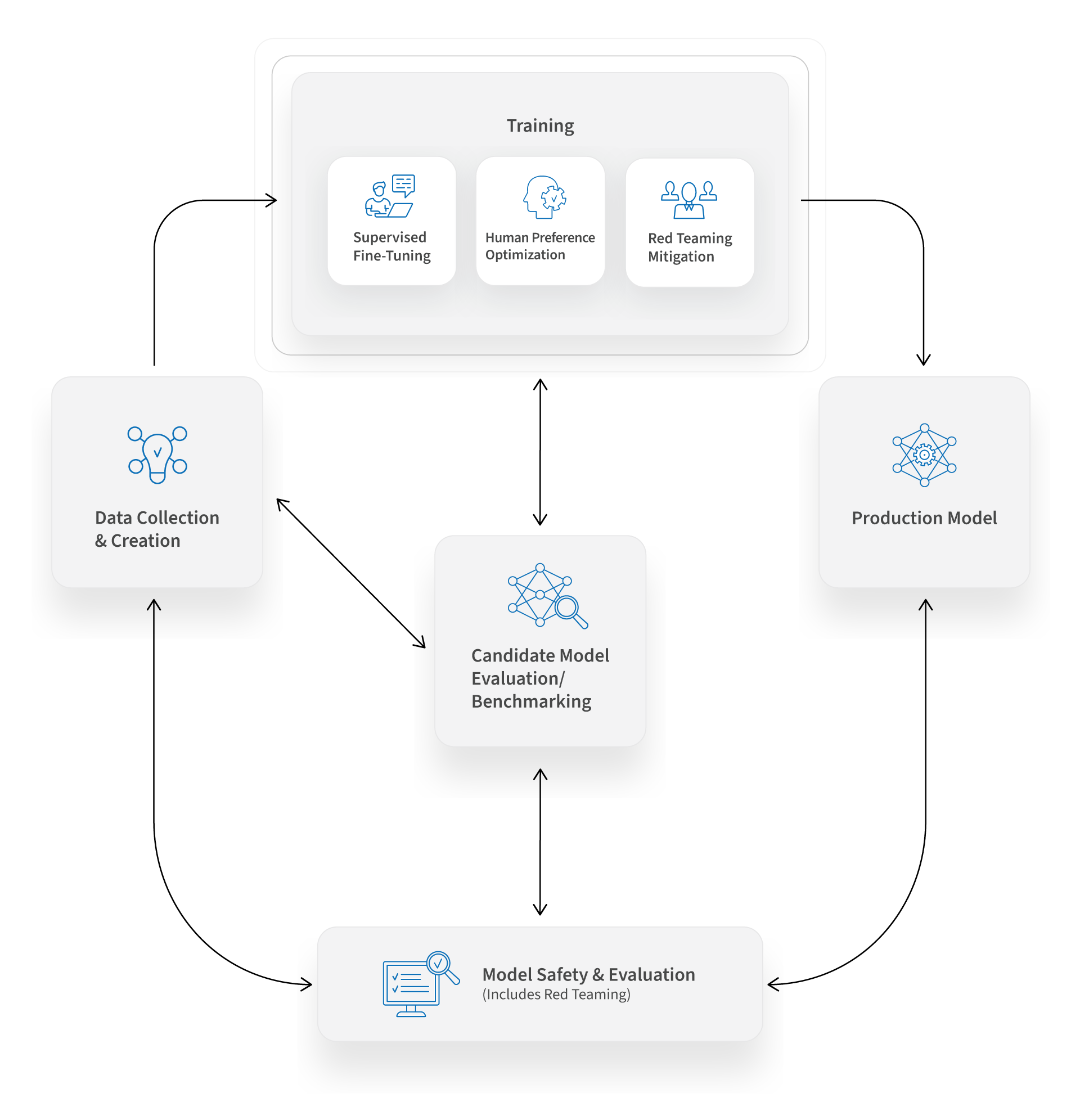GENERATIVE AI
Data Solutions
Trusted Data Solutions for Powerful Generative AI Model Development

Fuel Advanced AI/ML Model Development With Data Solutions for Generative AI


Data Collection & Creation
Our global teams rapidly collect or create realistic and diverse training datasets tailored to your unique use case requirements to enrich the training of generative AI models.
Additionally, develop LLM prompts with high-quality prompt engineering, allowing in-house experts to design and create prompt data that guide models in generating precise outputs.
Supervised Fine-Tuning
Linguists, taxonomists, and subject matter experts across 85+ languages of native speakers create datasets ranging from simple to highly complex for fine-tuning across an extensive range of task categories and sub-tasks (90+ and growing).
Human Preference Optimization
Improve hallucinations and edge-cases with ongoing feedback to achieve optimal model performance through methods like RLHF (Reinforcement Learning from Human Feedback) and DPO (Direct Policy Optimization).
Model Safety, Evaluation, & Red Teaming
Address vulnerabilities with Innodata’s red teaming experts. Rigorously test and optimize generative AI models to ensure safety and compliance, exposing model weaknesses and improving responses to real-world threats.
Data Collection & Creation
Naturally curate or synthetically generate a wide range of high-quality datasets across data types and demographic categories in over 85 native languages.
Our global teams rapidly collect or create realistic and diverse training datasets tailored to your unique use case requirements to enrich the training of generative AI models.
Additionally, develop LLM prompts with high-quality prompt engineering, allowing in-house experts to design and create prompt data that guide models in generating precise outputs.
of respondents in a recent survey said their organization adopted AI-generated synthetic data because of challenges with real-world data accessibility.*
-
Data Types:Image, video, sensor (LiDAR), audio, speech, document, and code.
-
Demographic Diversity:Age, gender identity, region, ethnicity, occupation, sexual orientation, religion, cultural background, 85+ languages and dialects, and more.
Supervised Fine-Tuning
Linguists, taxonomists, and subject matter experts across 85+ languages of native speakers create datasets ranging from simple to highly complex for fine-tuning across an extensive range of task categories and sub-tasks (90+ and growing).
of respondents in a recent survey said fine-tuning an LLM successfully was too complex, or they didn’t know how to do it on their own.*
-
Sample Task Taxonomies:Summarization, image evaluation, image reasoning, Q&A, question understanding, entity relation classification, text-to-code, logic and semantics, question rewriting, translation…
-
SFT Techniques:Change-of-thought, in context learning, data augmentation, dialogue…
Human Preference Optimization
Rely on human experts-in-the-loop to close the divide between model capabilities and human preferences. Improve hallucinations and edge-cases with ongoing feedback to achieve optimal model performance through methods like RLHF (Reinforcement Learning from Human Feedback) and DPO (Direct Policy Optimization).
of respondents in a recent survey said RLHF was the technique they were most interested in using for LLM customization.*
-
Example Feedback Types:DPO (Direct Policy Optimization), Simple RLHF (Reinforcement Learning from Human Feedback), Complex RLHF (Reinforcement Learning from Human Feedback), Nominal Feedback.
Model Safety, Evaluation, & Red Teaming
Address vulnerabilities with Innodata’s red teaming experts. Rigorously test and optimize generative AI models to ensure safety and compliance, exposing model weaknesses and improving responses to real-world threats.
reduction in the violation rate of an LLM was seen in a recent study on adversarial prompt benchmarks after 4 rounds of red teaming.*
-
Techniques:Payload smuggling, prompt injection, persuasion and manipulation, conversational coercion, hypotheticals, roleplaying, one-/few-shot learning, and more…
Why Choose Innodata for Your Generative AI Data Solutions?
Global Delivery Locations + Language Capabilities
Innodata operates global delivery locations proficient in over 85 native languages and dialects, ensuring comprehensive language coverage for your projects.
Quick Turnaround at Scale with Quality Results
Domain Expertise Across
Industries
With 5,000+ in-house SMEs covering all major domains from healthcare to finance to legal, Innodata offers expert annotation, collection, fine-tuning, and more.
Linguist + Taxonomy Specialists
Our in-house linguists and taxonomists create custom taxonomies and guidelines tailored to generative AI model development.
Customized Tooling
Looking to Implement Generative AI Into Your Business Operations?
Innodata’s team of experts help assist in integrating generative AI models into your business operations. We will guide you through the process, from identifying strategic opportunities to implementation to ensuring continuous success.

CASE STUDIES
Success Stories
See how top companies are transforming their AI initiatives with Innodata’s comprehensive solutions and platforms. Ready to be our next success story?
















